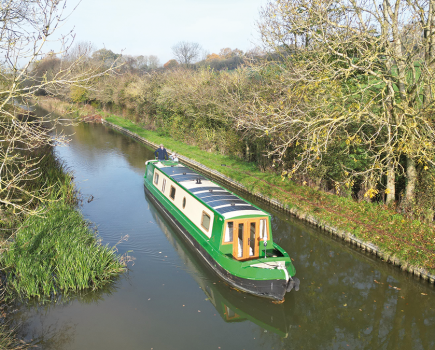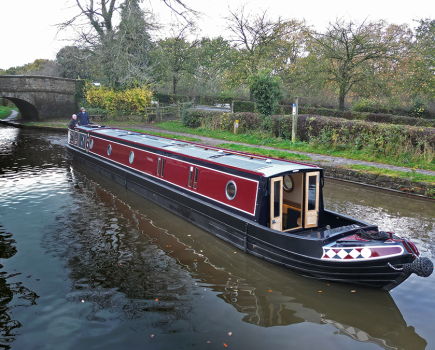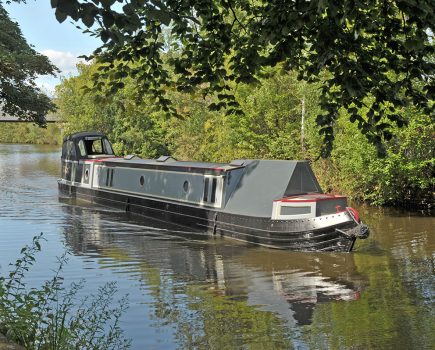The Whitsuntide No.2 is a fitting tribute to a company of craftsmen who made sure this newbuild hybrid narrow boat had a home to go to…
Designing the layout of a narrowboat is almost the definition of the old saying about trying to get a quart into a pint pot. With space limited, something usually has to give – either you don’t have something you want, or you make the boat a bit longer. And we’ve lost count of the number of boats we’ve tested which were supposed to be 57ft but ended up at 60ft, or should have been 58ft but became 62ft. And then there are the ones which were intended as a 62ft, and the owners realised they might as well go the whole hog and take the full 70ft.
But here’s a boat whose owners didn’t have the luxury of adding a couple of feet when things got tight – because they already had a mooring, and that mooring was 52ft long. Whatever else happened, the boat absolutely could not end up longer than the mooring.
And as it happens, that’s quite an achievement because one of the main requirements was that boat had two cabins (which frankly isn’t easy to fit into a longer boat, let alone a 52-footer). It’s also a hybrid, which means there needs to be room for a substantial battery bank. The builders are Trinity Boats, based not far from Droitwich.

EXTERIOR
Whitsuntide No2 (the owners had a little Viking cruiser named Whitsuntide many year ago, which they bought at that time of year) is built on a Mike Christian shell by Tyler Wilson. Mike Christian is the name the firm gives to their slightly less detailed hulls – so there are no scrolls in the handrails and cants for example. But the steelwork is still to their usual high standards, and importantly the underwater shape is still the same, so you get nice long swims to aid good handling. What’s more, the lines are nice, with an attractive bow shape and a subtle lift at the stern.
At 52ft, this is quite a short boat, so the well deck is fairly compact – although there’s still room to sit outside, and everything still looks in proportion. It’s a semi-trad stern, and there are lockers both sides of the deck to give somewhere for the crew to sit while keeping the helmsman company.
As this is a hybrid boat, it’s also gas-free, meaning the lockers are all available for storage. This is also true at the bow, where there are also lockers both sides of the deck, while the space in the nose also offers a lot of storage space and is accessed by a really big hatch.
The colour scheme uses a couple of greens – a dark shade for the gunwales and the borders, and a colour called moss grey for the cabin-side panels – a name which for once accurately describes the colour. It’s rather attractive, being both subtle and interesting.
The roof and handrails are dark red, giving a traditional look, and all the trim is in a brass finish. This is fairly unusual these days as many owners prefer chrome or stainless steel which requires less looking after – but the brass suits this boat very well.
It’s an all-porthole boat, with frames by Cauldwell’s in a brass finish, and with double-glazed glass.All in all, it’s a boat which looks elegant and classy.

LAYOUT AND FITOUT
This is essentially a standard layout boat with a saloon and galley at the bow, a cabin at the stern, and a shower room in between. But there is also the addition of a second cabin in the middle of the boat. The fitout uses colours and tones which reflect the colour scheme outside.
The hull sides are painted tongue and groove effect, while the cabin sides are a marine vinyl This has a 3mm foam backing, which provides a bit of extra insulation, but is also UV stabilised, mildew and stain resistant, and fire retardant.
It’s a material more often found in yachts.The bulkheads and furniture are made from a laminated plywood in an oak effect finish, while all the trim is solid oak.There’s extensive use of Harris tweed, and all the fixtures and fittings are brass.
It makes for a very harmonious and relaxed feel inside.The floor is a luxury vinyl tile in a stone effect, which should be very hardwearing.

MAIN CABIN
We’ll start at the stern, where a set of ladder steps leads down into the boat from the rear deck. There are wardrobes on both sides, providing plenty of storage space; the stern-most is split into two, with the bottom half accessible only when the steps are moved out of the way.
On the other side, the cupboard faces into the boat.This doubles as the electrical cupboard containing the inverter and the control box for the hybrid system among other things – but cleverly these are behind an inner door – so the space in front is still useable storage.
The bed is built in-line, and extends thanks to a pull-out section. The base includes a number of drawers, although some of the space here is taken up by the loo tank and by the calorifier. At the head of the bed is a very attractive Harris tweed padded headboard, which gives a real feeling of comfort and luxury. It fills up the whole space between the mattress and the overhead cupboards. These cupboards contain charging points, and there are reading lights underneath, finished in brass.
Rather than curtains, there are nicely made porthole bungs throughout the boat. An anthracite grey column radiator finishes off the room.

SHOWER ROOM
It turns out that shower cubicles are not available in a brass finish, which is a bit of a shame as it would have matched better. The rectangular cubicle is a very good size, though, at 700 x 760mm; it’s lined with a shower board in a tile effect, which looks very smart.
A large vanity unit provides lots of storage space, and is topped with a very large and stylish rectangular white basin, with a chrome tap. There’s also a shaver socket.There is a grey column radiator on one side of the room, and a matching towel rail on the other.
The loo is a macerating unit by Jabsco, with the holding tank immediately behind, under the bed. This means the pipework between the two is mercifully short.
The doors at either end of the room have been purpose-built to fit, and are made of solid oak. A nice touch is the magnetic pop-up door stops, which hold the doors open. When not in use, they’re flush to the floor, so there’s nothing to stub your toe on, or trip over.

MID CABIN
This is a more compact version of the main cabin, being only as long as the bed itself. The bed base extends widthwise in the same way, there’s the same oversized Harris tweed headboard, and the same high-level cupboards.
Because there’s no tank in the bed base, there are extra drawers – meaning there’s a decent amount of storage even without a wardrobe.

GALLEY
This is a very smart and stylish galley, which also feels very spacious.There’s a set of side doors on one side with glazed inners. Because of the positioning, close to the cabin door, these inner doors fold back in bi-fold fashion, and are then magnetically held against the wall.It’s a neat and well engineered solution.
The kitchen units all come from Howdens. Using ready made units allows for a much speedier boat build – and they’re still decent quality. The doors are dark green, to match the colour scheme of the whole boat, while the worktops are made from quartz in a marble effect finish. There’s a large under-mounted Belfast sink, with a brass tap.
One cupboard is a pull-out bin with a recycling section, and there’s also a pull-out storage unit. As this is an all-electric boat with plenty of power available, there’s a 240 volt full-size fridge with an ice box, and cooking is electric too.
The oven is by Bosch, while the induction hob by Neff has four cooking zones.

DINETTE/SALOON
After the spacious galley, this seating area is where the boat feels as though it’s run out of room (which, frankly, it has – given the second cabin). However, all boats are compromises, and I’m not surprised the owners opted for a set-up which is more dinette and less saloon; in my own boat, we spend far more time sitting at the dinette than in the saloon, and I’m sure many other boaters do too.
There are built-in bench seats each side which can double as single berths. One has drawers in the base, while the other has a flap which gives access to a space to store the table when it’s not in use.
The table itself is generously wide, which is good when you’re sitting at it, but not so good when you need to get past to the front doors. It sits on Desmo legs which means it is easy to take down.The seats are beautifully upholstered in more Harris tweed.There is no television on board, with the owners just not wanting one.The brass sockets have USB ports for charging devices.
As there’s no wall space available on which to hang a radiator, instead there’s a heater in the front step, which operates from the central heating system. The doors out to the well deck are double glazed UPVC units, which offer a high level of security and sound proofing.They are grey rather than white on the outside, so they don’t stand out.

TECHNICAL
Whitsuntide No2 is powered by the hybrid system from Hybrid Marine, with which we’re becoming increasingly familiar. It’s based on a Beta 43hp engine with a 10kw electric motor bolted on one end.This acts as a motor to drive the prop when in electric mode, and converts into a generator to charge the batteries when the Diesel engine is running.
The other boats with this system that we’ve seen in the past couple of years have all had the enhanced package, with a battery bank of 800Ah at 48 volts; but this is a shorter boat, and such a big battery bank would have been too heavy at the stern, and made ballasting very difficult. So it has the standard bank of 400Ah at 48 volts. That’s still very significant – the equivalent at 12 volts would be 1600Ah.
The bank of 2 volt cells is arranged in a U-shape just inside the stern of the boat.The batteries have a watering system fitted, and are self-venting. There are also two 12 volt batteries, one for the engine starter, and another which powers the 12 volt systems on the boat — such as the lighting and the pumps.
There’s a cross-charger to keep these batteries topped up from the 48 volt system. For a 240 volt supply, there’s a 5kw Victron inverter – which is big enough to cope with the electric cooking on board. The batteries can be charged in a variety of ways.There’s the electric motor when the diesel engine is being used, a shoreline if the boat is in a marina, and a significant solar array.
There are six semiflexible panels, amounting to 720 watts.If you’re travelling along on a sunny day, the panels can actually put more into the batteries than the motor is taking out – which must be the ultimate in green transport.
There’s an app linked to the controller, so you can see how much power is going in.Hybrid Marine say the 400Ah battery bank should provide 3 to 5 hours of continuous canal cruising.Of course if you’re doing a flight of locks, there’s plenty of time when no power is being used at all, and you’re not wasting energy idling the engine.The central heating is from a Webasto diesel boiler.

ON THE WATER
We tested the boat under electric power, and once again the most remarkable thing is the quietness.It may be my imagination, but it seems to me that electric motors are becoming quieter as the technology improves.
Louder is the gentle ripple of water along the hull and past the prop; you can also hear what people are saying to you from the towpath, and you can creep up on anglers without them noticing. As you go along, a display shows you what percentage of the available power you are cruising at, and what you’re taking out of the batteries. Even with this information, when you’re used to judging speed by engine note, it takes a while to get used to estimating how quickly you’re moving.
An electric motor does allow you to move incredibly slowly – much slower than a diesel’s tickover. The Tyler Wilson shell handles well, as you might expect. We turned with ease, and it was gratifying to find that the bow really responded to putting the tiller over and giving a blast of power.
Image(s) provided by:
Archant








